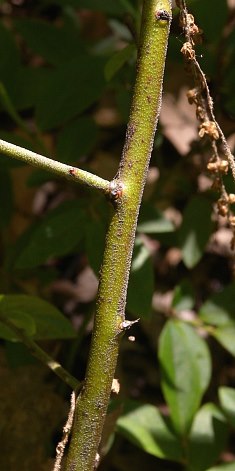
Small clusters of nodding flowers develop from the preceding year's twigs. Each flower is about ¼" long and a little less across, consisting of a short green calyx with 5 teeth, a short-tubular corolla that is white or pinkish white, 10 inserted stamens, and an inferior ovary with a single style. The corolla is slightly indented along its upper rim, where 5 tiny lobes occur that are recurved. The peduncle and pedicels of the clustered flowers are light green to reddish brown and glabrous. The blooming period occurs from late spring to early summer for about 3 weeks. Afterwards, fertile flowers are replaced by globoid berries up to 1/3" (8 mm.) across that become dark blue with a whitish bloom at maturity. At this time, the fleshy interior of each berry is juicy and sweet and it typically contains 10-15 tiny seeds. The root system is usually shallow and spreading, although a taproot may develop on an older shrub. Vegetative colonies are produced from underground runners. The deciduous leaves often become red or burgundy during the the autumn.
Cultivation: The preference is full sun to light shade, mesic to dry conditions, and an acidic soil that is sandy. Cross-pollination between genetically distinct shrubs increases the production of fruit. This shrub may fail to produce flowers and fruit in areas that are too shady.
 Range
& Habitat: The native
Lowbush Blueberry is occasional in NE Illinois (see Distribution
Map).
Habitats include sand prairies, shrub prairies, sandy savannas,
sandy woodlands, rocky upland woodlands, rocky bluffs, sand dunes along
Lake Michigan, and bogs. Lowbush Blueberry is sometimes the dominant
understory shrub in some of these habitats, especially when they are
sandy. This shrub becomes more abundant in response to occasional
wildfires and the openings that such wildfires create.
Range
& Habitat: The native
Lowbush Blueberry is occasional in NE Illinois (see Distribution
Map).
Habitats include sand prairies, shrub prairies, sandy savannas,
sandy woodlands, rocky upland woodlands, rocky bluffs, sand dunes along
Lake Michigan, and bogs. Lowbush Blueberry is sometimes the dominant
understory shrub in some of these habitats, especially when they are
sandy. This shrub becomes more abundant in response to occasional
wildfires and the openings that such wildfires create.Faunal Associations: The flowers are cross-pollinated primarily by various bees, including Andrenid bees (Andrena spp.), bumblebees, and honeybees. Both nectar and pollen are available as floral rewards. The pollen is released from the anthers in response to the "buzz pollination" of the bees (high frequency vibration of the thoracic muscles). In addition to these floral visitors, many insects feed on the foliage, stems, and other parts of blueberry shrubs. For example, the larvae of two beetles, Oberea myops (Rhododendron Stem Borer) and Oberea tripunctata (Dogwood Twig Borer), bore through the twigs of these shrubs, while the larvae of two flies, Dasineura cyanococci and Dasineura oxycoccum (Blueberry Gall Midge), form galls on the buds or developing flowers. Other insect feeders include the leaf beetles Altica sylvia and Tricholochmea vaccinii, the larvae of Rhagoletis mendax (Blueberry Fruit Fly), Clastoptera saintcyri (Heath Spittlebug), Limotettix vaccinii (Blunt-Nosed Leafhopper), and Mesolecanium nigrofasciatum (Terrapin Scale). The caterpillars of two butterflies, Callophrys augustinus (Brown Elfin) and Callophrys henrici (Henry's Elfin), feed on the flowers and developing fruits of blueberry shrubs. In addition to these insects, the caterpillars of such moths as Hemaris gracilis (Slender Clearwing), Sympistis dentata (Blueberry Cinder), and Xestia dilucida (Reddish Heath Dart) also feed on these shrubs. The Insect Table has a more complete list of these insect feeders. Blueberry fruits are an important source of food to many vertebrate animals. These species include the terrestrial turtles, Clemmys insculpta (Wood Turtle) and Terrapene carolina (Eastern Box Turtle); such birds as the Ruffed Grouse, Wild Turkey, Blue Jay, American Robin, Yellow-Breasted Chat, Wood Thrush, and Eastern Bluebird (see the Bird Table for a more complete list of these species); and such mammals as the American Black Bear, American Red Fox, Gray Fox, Striped Skunk, Franklin's Ground Squirrel, Fox Squirrel, Least Chipmunk, Woodland Jumping Mouse, Deer Mouse, and White-Footed Mouse (Ernst et al., 1994; Martin et al., 1951/1961; Hamilton, 1941; Haugen, 1942; Schmidt, 1931; Beeman & Pelton, 1980; Mosnier et al., 2008; Romain et al., 2013; Noyce & Coy, 1990). In addition to the fruits, the White-Tailed Deer and Cottontail Rabbit also browse on the foliage and twigs. Because Lowbush Blueberry is a densely branched shrub that often forms large colonies, it provides significant protective cover for ground-nesting birds and other wildlife, including the endangered Kirtland's Warbler.

Photographic Location: A sandy woodland near Lake Michigan at the Indiana Dunes State Park in NW Indiana.
Comments: Lowbush Blueberry (Vaccinium angustifolium) is one of the primary sources of commercial blueberries, particularly in the New England region of the United States. The flavor of the berries is sweet and mild. Because this shrub is somewhat variable across its range, different varieties have been described, although none of these are currently recognized in Illinois. Compared to the Hillside Blueberry (Vaccinium pallidum), Lowbush Blueberry has more narrow leaves and its leaf undersides are less pale. It differs from another species, Canada Blueberry (Vaccinium myrtilloides), by having leaf undersides that are glabrous, rather than pubescent. These species usually occupy drier habitats than the taller Highbush Blueberry (Vaccinium corymbosum); the latter is typically found in forested bogs and similar wet habitats.